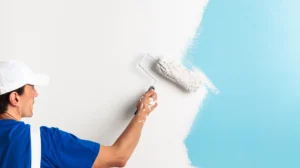
Best Paint for Wood
Painting wood protects it from the elements, from cracking and seals it so it ages well. Depending on if the wood is interior or exterior,
Have you ever tried to paint a home that was covered in incredibly busy wallpaper? (To envision this, think of the décor and wallpaper at your grandma’s house. Yeah, that kind of busy.) Some homes have quirks and interesting décor choices from the previous homeowners. For example, your friend might have just moved into a home that is completely doused in old-fashioned wallpaper. They’ve called you, trying to recruit you to help them paint over it and it seems like an impossible job. What do you do now?
Well, lucky for you it is possible to paint over wallpaper successfully. This article will tell you about all the tips and tricks you need to know to have a stunning, clean, and long-lasting paint job on your walls with existing wallpaper.
You might think that you could scrape all of the ugly wallpaper off your walls and start from scratch. Sometimes, scraping your wallpaper off can cause even more problems for your existing walls. Your walls can become damaged and uneven, making it nearly impossible to get a smooth, clean paint job. Even if your wallpaper does come off easily, you might find that there was a certain reason the former homeowners put down wallpaper in the first place. The walls underneath might be in bad condition. You then would need to put in a lot more time and money to make the walls look better.
So, if you’ve decided to paint over the wallpaper in your house, you’ll need to gather some supplies. Here is a list of the essentials that will help you have a successful painting project.
First, you may need to clean the wallpaper to help the primer and paint stick successfully and permanently. Rubbing the walls with a little damp rag and some cleaning solution can help to remove dust, grime, and other build-up that has occurred over the years. Make sure you don’t get them too wet or the wallpaper will sustain damage.
Once the wall is completely dry, you’ll need to prepare the wall for the paint by repairing any tears in the wallpaper and applying the primer. Use drywall spackling to seal up those tears and sand away any leftover texture. If you’d like to add texture to your wall, you can do so with a little extra spackling. Before you apply your primer, remember to tape off any surfaces, such as crown molding, that you don’t want to be painted or primed. However, smooth walls are usually on-trend these days. Next, use your paint roller and brushes to apply a thorough coat of primer over the entire surface that will be painted.
When you’re painting, similar to when you’re adding your primer, make sure to start by cutting in the corners. This just means that you’ll start off your paint job by painting the hard-to-reach spaces, like the corners. Once you’re done painting those small spaces, you’ll use your paint rollers to quickly cover the remaining large spaces. You’ll likely need a few coats, especially if your wallpaper is especially vibrant, but using a good-quality primer can help to minimize the number of coats of paint that you’ll need.
When it comes to painting over wallpaper, your primer will dictate which base of paint you should be using. If you use the recommended oil-based paint primer, you can use either water or oil-based paint as a result. Not using the correct type of primer could make it more difficult to find paint that adheres properly. A high-quality interior wall paint brand, such as Vista Paint, will supply you with paint that doesn’t scratch or fade with time.
If you’re wondering what color of paint will color your walls the best, you shouldn’t be. You should choose the color of paint that you love, the color that will help your room and interior feel warm and inviting. You shouldn’t feel forced to use a dark paint color just because it will cover your 70’s era wallpaper successfully. (Although if you love the drama of dark paint colors, then go for it!) If you use oil-based primer in the way that this article has described and instructed, then you should be free to use whatever shade of paint your heart desires. Even if you choose a white or pastel color, you should be able to cover any pattern or shade of wallpaper as long as you use an oil-based primer and a few extra coats of paint. So, the presence of existing wallpaper shouldn’t ruin your hopes and dreams for a trendy, beautiful house!

Painting wood protects it from the elements, from cracking and seals it so it ages well. Depending on if the wood is interior or exterior,

Have you ever tried to paint a home that was covered in incredibly busy wallpaper? (To envision this, think of the décor and wallpaper at

You’ve just been through a big move after spending weeks packing and organizing. However, you won’t be able to feel happy and comfortable in your

Painting wood protects it from the elements, from cracking and seals it so it ages well. Depending on if the wood is interior or exterior,

Have you ever tried to paint a home that was covered in incredibly busy wallpaper? (To envision this, think of the décor and wallpaper at
© 2024 Vista Paint Corporation